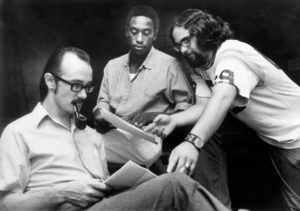The Murder Trial
Ronald Greenfield didn’t look like a murderer. From my seat in a Charlottesville, Virginia, courtroom in June, 1973, I thought he looked more like one of the tenth grade students I had taught at  Albemarle High School. Short, pudgy, with curly shoulder-length black hair, he appeared younger than his seventeen years, but he was on trial as an adult for murder.
Albemarle High School. Short, pudgy, with curly shoulder-length black hair, he appeared younger than his seventeen years, but he was on trial as an adult for murder.
That summer I had finished my first year in law school, and I clerked for a lawyer in Charlottesville. When Commonwealth v. Greenfield came to trial, he encouraged me to watch the proceedings in between projects as a learning experience. In three sessions, I saw six hours of the trial.
The prosecution’s witnesses set the backdrop. In November, 1972, Greenfield had worked for a short time as a doorman for Poe’s, a tavern that catered to UVA students. He was from Brewster, New York. His father was a dentist there. His co-workers described him as a “drifter.”
Twenty-one years old, Mary Frances Jordan was a senior in UVA’s Education School. She worked for Poe’s as a waitress.
About 12:30 a.m. on November 8, Greenfield asked around for a ride home after work because of heavy rain. Jordan offered him a lift. She drove him to the Westminster Presbyterian Church parking lot on Rugby Road, next to his apartment.
Greenfield testified that they talked for a while. He said he “shot up” heroin that night at six p.m. and took psilocybin, a powerful hallucinogenic, at nine, and Jordan “bugged” him about his drug use. He resented it, but he claimed their conversation ended on a good note.
When he got out of the car, he experienced a “falling” sensation. The next thing he remembered he awoke in a “crouched position” on the driver’s side of the car. He saw Jordan lying motionless in a pool of blood. His hand was bleeding. He saw his penknife on the floorboard and picked it up. He thought he had “freaked out” and killed her.
Thomas Keevan lived near the lot. He testified he ran outside when he heard screams and he saw someone running from the lot dressed in a green army jacket. Greenfield wore a green army jacket that night. Keevan found Jordan bleeding, but alive. He carried her to his apartment and called the rescue squad and the police.
 Greenfield fled to a house nearby. A student there testified that he said he’d killed a narcotics agent and a girl. He asked for a ride out of town and money. No one would help him, so he ran to railroad tracks near Rugby Road and hid there.
Greenfield fled to a house nearby. A student there testified that he said he’d killed a narcotics agent and a girl. He asked for a ride out of town and money. No one would help him, so he ran to railroad tracks near Rugby Road and hid there.
Jordan died at the UVA hospital at 2:55. Her murderer had stabbed her twenty-one times in the chest, abdomen, arms, and head, and punctured her liver and lungs.
At daybreak Greenfield walked to a main road to hitch a ride to Richmond. Basil Miller, a truck driver, said he picked up Greenfield and drove him to a first aid station because his hand was badly cut. Miller later heard the description of the murder suspect on the radio and called the police.
The police testified they found Greenfield in a Richmond hospital and arrested him. They said he volunteered that he killed Jordan with a penknife they found in his pocket and that he told them, “I don’t feel bad about taking a human life.” Greenfield denied this.
The most dramatic session I attended came just before Greenfield took the stand. One of my law school professors had joined the defense team. Outside the presence of the jury, he told the judge that Greenfield could recall certain facts only when hypnotized. While in a trance, he remembered a karate blow to the back of his neck that knocked him out. When he awoke, he saw a man wearing a jacket like Greenfield’s in the parking lot. He chased the man, but lost him. My professor asked the judge to allow Dr. Kenneth Locke to hypnotize Greenfield and have him testify while in a trance, or in the alternative, to allow Locke to testify about what Greenfield remembered under hypnosis.
The admissibility of testimony under hypnosis was a matter of first impression in Virginia. The judge refused to allow it on the basis that jurors might regard the hypnotic state itself as proof of truth even though a witness could invent false statements while pretending to be in a trance. The defense team went ballistic because Greenfield’s hypnotically induced memory of the “other man” was their only direct evidence that someone else killed Jordan.
The judge stood firm against an avalanche of passionate advocacy and then ordered a recess for everyone to cool down. After the break, Greenfield took the stand, marching to the witness chair with slow robotic strides and a far-off look in his eyes.
The commonwealth’s attorney asked to approach the bench. With the jury out of the room, he accused the defense of hypnotizing Greenfield during the break. Defense counsel didn’t admit it, but they didn’t flat out deny it either. After major fireworks, the judge surprisingly decided not to sanction them and recessed again. When Greenfield returned to the stand, he testified normally and didn’t mention the other man.

I wasn’t there when the jury rendered its verdict, but the news swept through town like a thunder storm. The jury found Greenfield guilty of second degree murder and the judge sentenced him to twenty years. The overwhelming sentiment of the community was that Greenfield committed first degree murder and deserved a life sentence.
Mary Jordan had planned to be an elementary school teacher. Her co-workers at Poe’s described her as smart, sensitive, and fun. The manager said she was like family. “We’re not putting you on. She was a wonderful person.” Two hundred UVA students made the drive north to Arlington to attend her funeral the week after her murder. UVA established a fund in her name.
From his arrest onward, Greenfield seemed unfazed by the gravity of the murder. Upon his arrest, he said, “I don’t feel bad about (the murder).” While he sat in jail pending trial, he sent a letter to the UVA student newspaper complaining about jailhouse living conditions. His meals were inedible, he wrote. The food was cold. He was allowed only two cold showers a week and was forced to shave without a mirror. And during the sessions of the trial I watched, he showed no remorse.
After the conviction, Thomas and Amelia Jordan sued him for the wrongful death of their daughter. They won a damage award, but I doubt they cared about the money. I think they wanted to make a statement to Greenfield: their daughter’s life mattered.
Greenfield appealed his conviction and lost. In 1974 he led a press conference to protest living conditions in the penitentiary. He was a ringleader of a prisoner’s strike in 1977, and he was later one of seven, who filed an unsuccessful lawsuit about prison conditions. My internet research trail of Greenfield goes cold in 1980. I couldn’t find records about his release, but if he served his full sentence, which is unlikely, he was 37 in 1992 when he got out; he’s 61 today; and he’s been free for at least 24 years, longer than Mary Jordan’s entire lifespan.
This was the first trial I watched and I learned a lot, but the outcome left me cold. In my view, Greenfield’s punishment didn’t fit his crime. Criminal sentencing should balance the need for punishment with the opportunity for rehabilitation, but when you take someone’s life for no reason in a savage frenzy of bloodlust, drug-induced or not, I believe you should forfeit your freedom for life, and along with it, your chance to rehabilitate. Mary Jordan is dead. She got no second chance. Maybe I’m being too harsh, but even if I’d thought in 1973 that Greenfield could rehabilitate and turn his life around, I would have voted as a juror for guilty of first degree murder with a sentence of imprisonment for life.



May 4, 2023 @ 7:22 pm
I was one of Mary Jordons best friends in Arlington Va. Her Murder has always devestated me and changed me forever.. i.never stopped missing her.. Mimi
May 6, 2023 @ 8:13 am
Thank you, Mimi, for reading my blog. I’m so sorry for the loss of your friend. My time watching the trial and my research for writing this post proved that Mary Jordan was a wonderful person. Her murderer deprived the world of a beautiful human being with great promise. Patricia Jordan, Mary’s younger sister, sent a comment about her sister some time ago. Since you were a close friend of Mary, you probably know Patricia. If you go to the post and click on Comments, you can see her expression of grief about her sister’s death.
Thank you again for giving me and my readers more insight about Mary Jordan.
January 3, 2021 @ 12:33 pm
I am Mary Jordan’s sister and just saw your post. I was 15 when my sister died. I visit her grave twice a year and each time I cry. Thank you for this thoughtful analysis. You are correct. He should have received first degree murder. Furthermore, Greenfield was released after only 7 years in prison. How did that ever happen?
As the article indicates, my sister was truly a wonderful person. I miss her still and think of her often. The pain never goes away.
Patricia Jordan
January 4, 2021 @ 2:48 pm
Thank you, Patricia, for reading my post and for reaching out to me. I am so sorry for your loss. It was clear from my research that your sister was a special person. I’m also sorry our justice system failed you and Mary Jordan’s loved ones. I couldn’t find a record of Greenfield’s release so your message that he only served seven years is a depressing revelation to me. I don’t know how or why he got out so early, but it is clearly a travesty. I hope the knowledge that your sister was loved and admired widely at UVA is some consolation, although I realize nothing can make up for her loss. Thank you again for contacting me.
November 19, 2016 @ 2:16 pm
Wow, my common refrain for your posts. Awesome, captivating. Love the story and your delivery.
November 19, 2016 @ 1:56 pm
You know how much I enjoyed The Closing, Ken. I definitely see remnants of this trial in your book and LOVED the tie. What a sad, powerful story. Thanks for sharing.